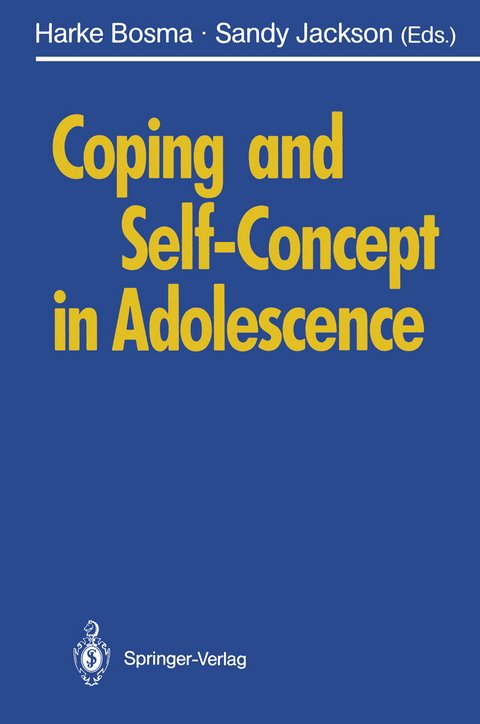
Coping and Self-Concept in Adolescence
Springer Berlin (Verlag)
978-3-642-75224-7 (ISBN)
1 Coping and Self in Adolescence.- Coping and Developmental Tasks.- Self-Concept and Identity.- Coping and Identity.- Plan of the Book.- 2 The Problem of Self-Conceiving.- Self-Concept, Self-Conception, and Self-Conception Problems.- Self-Conception Problems in Adolescence: The Contribution of Erikson.- Some Controversies and Alternatives.- Conclusion.- 3 Coping and Development.- Adolescence - A Period of Disturbance or of Active Coping?.- Coping in Adolescence: Concepts and Theory.- Personality and Development in a Coping-Theoretical Perspective.- Normally Developing and Troubled Adolescents.- Concluding Remarks.- 4 Developmental Processes in Self-Concept and Coping Behaviour.- Dimensional Structure of Self-Concept and Coping; Age and Sex Differences.- Stability and Continuity of Self-Concept and Coping.- Relationship Between Self-Concept and Coping.- Clinical Significance of Self-Concept and Coping Style.- Cross-Cultural Differences in Self-Concept and Coping Style.- Conclusions.- 5 Selves-in-Relation: School Leavers' Accommodation to Different Interpersonal and Situational Demands.- Selves-in-Relation.- Early School Leavers in the United Kingdom.- Young School Leaver's Accommodation to Post-school Life.- Results.- Discussion.- 6 Ego-Strength Development and Pattern of Social Relationships.- Design of the Constance Longitudinal Study.- Developmental Patterns in Adolescence.- Definition of Intra-Individual Change in Ego-Strength.- Ego-Strength Development and the Pattern of Social Relationships in Adolescence.- Conclusions.- 7 Adolescents' Orientations for Development.- Present-State and Future-Time Perspective: Age Trends and Sociodemographic Variation.- A Typology of Patterns of Change in Present-State and Future-Time Perspectives.- Transition into Occupational Preparation in Relation to Self-Esteem.- Transition into Intimate Partnership in Relation to Self-Esteem, Friendship Conceptions and Leisure-Time Activities.- Conclusion and Prospects.- 8 Self Through Relationship Development.- Relationship Development: Methods of Investigation.- The Self in Relationships.- The Self in Parent-Child Relationships.- The Self in Children's Friendships.- The Self in Adolescent Friendships.- The Self in Adolescent-Parent Relations.- Conclusions.- 9 Continuity and Commitment: A Developmental Analysis of the Identity Formation Process in Suicidal and Non-suicidal Youth.- One: On Being Counted Only Once - The Problem of Numerical Identity.- Why Being or Having a Self Requires a Conviction of Personal Continuity.- Two:A Typology of Possible Continuity Warrants.- Relations of Structural Similarity.- Functional Relations of Equivalence.- Numerical Identity and Development.- Three: An Empirical Account of the Continuity-Warranting Practices of Suicidal and Non-suicidal Adolescents.- Summary and Conclusions.- 10 Anxiety in Adolescence: Sources and Reactions.- Method.- Results.- The Universe of Adolescents' Fears.- Reactions to Anxiety-Provoking Situations.- Relations Between Fear Situations and Reactions.- Conclusion.- 11 Coping with Difficult School Situations and Stress Resistance.- Adolescents' Response to Difficult Situations.- Results.- Individual Characteristics of Adolescents and the Difficult Situations They Experience at School.- Discussion.- 12 Coping and Self-Concept: Retrospect and Prospect.- Retrospect.- Prospect.- A Changed View of Adolesence.- Coping Rather than Crisis.- Coping and Self-Concept.- Further Research Issues.- Research Methods.- Optimalising Adolescent Development.- Intervention.- Conclusion.- References.- Author Index.
| Erscheint lt. Verlag | 13.12.2011 |
|---|---|
| Zusatzinfo | XI, 270 p. |
| Verlagsort | Berlin |
| Sprache | englisch |
| Maße | 155 x 235 mm |
| Gewicht | 440 g |
| Themenwelt | Sachbuch/Ratgeber ► Gesundheit / Leben / Psychologie ► Psychologie |
| Geisteswissenschaften ► Psychologie ► Entwicklungspsychologie | |
| Geisteswissenschaften ► Psychologie ► Pädagogische Psychologie | |
| Schlagworte | Anxiety • Behavior • Crisis • Development • Developmental Psychology • Entwicklungspsychologie • Identity • Jugend • Partner • Psychology • stability • Stress |
| ISBN-10 | 3-642-75224-1 / 3642752241 |
| ISBN-13 | 978-3-642-75224-7 / 9783642752247 |
| Zustand | Neuware |
| Haben Sie eine Frage zum Produkt? |
aus dem Bereich


